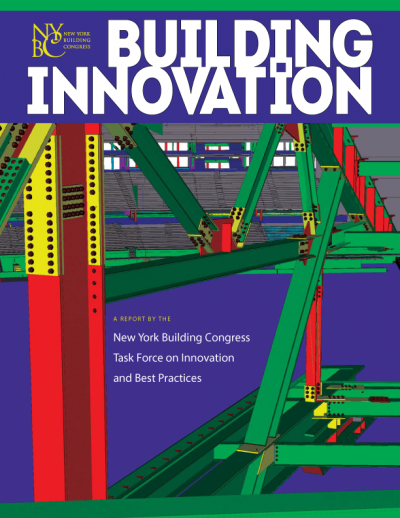
Building Innovation
Better Sidewalk Sheds, Better Streetscapes
 |
|
|
Side+Ways+Shed by Francis Cauffman |
In order to grow and prosper, New York City must continuously build, whether it is brand-new construction or renovation and modernization of existing structures. While the process of building is a welcome sign of a City in a constant state of reinvention, it can come at a temporary cost to the quality of life in and around individual building sites.
Given its close proximity to neighbors and the importance of public support for its work, the building community can and should seek ways to advance improved construction site management practices, while enhancing its image as a good neighbor and a welcome and essential part of the City's evolution. Nowhere is that more apparent than with the sidewalk sheds, which currently line nearly 200 miles of New York City streets.
 |
|
|
SCAFFOLDWING by Gannett Fleming |
"While New York City's sidewalk sheds have served the practical function of protecting pedestrians from construction taking place right over their heads, they have failed in terms of their impact on New Yorkers' quality of life," said Frank J. Sciame, Chairman and CEO of Sciame Construction LLC and Chairman of the Construction Site Management Committee "The goal of our committee was to seek fresh ideas from the industry on how to create a safe, thoughtful, and far more visually appealing sidewalk shed."
To generate ideas for improved construction shed designs, the Task Force joined forces with the New York Building Foundation to launch an industry-wide design competition in July 2015. Members of the building community were invited to submit one conceptual or schematic design for a buildable construction shed that would be evaluated based on aesthetics, ability to meet engineering standards, functionality, safety, and constructability.
 |
|
|
UrbanArbor by PBDW Architects and |
The goal was to leverage the expertise and ingenuity of the building industry to develop new shed concepts that could meet rigorous New York City Department of Buildings requirements while elevating the current standard design to address a major quality of life issue for New Yorkers, whose primary interface with the industry is passing underneath the imposing sheds.
Of 33 submissions, four winners were selected by an expert jury composed of architects, engineers, contractors, and building owners. The winning submissions met the design criteria in different ways, each presenting an innovative approach to reducing or eliminating the bracing that blocks natural light and interferes with the pedestrian experience.
The winning teams also demonstrated close attention to the aesthetics of their structures - creating off-the-shelf designs that will be more attractive than standard sheds. While elegant, all of the designs are simple to erect and use readily available materials, satisfying a key objective of the competition that the designs minimize additional costs to building owners and be easy to assemble to encourage adoption by the industry.
 |
| G-Shed by Gensler |
Although the selection of four imaginative and innovative shed design concepts is a promising first step, the longer-term objective is to see their broad implementation throughout the City. This will require securing the City's buy-in as well as increasing awareness and promoting use of the new shed designs among owners and general contractors.
The Task Force recommends that:
- The Building Congress, working with other industry organizations, should expand efforts to increase awareness and promote the use of the new shed designs among owners and general contractors, including by facilitating meetings with shed designers and shed supply firms and supporting measures to enhance the constructability and/or affordability of the new shed designs. Government should use the new shed designs and find ways to encourage privatesector use of them on public projects.
- Owners and contractors should consider the new shed designs and implement them, where feasible, on upcoming projects. Experiences using the new shed designs should be promoted and shared with industry colleagues.
- "The New York Building Congress issued a challenge to the entire industry to use its ingenuity and expertise to offer fresh ideas for solving a vexing quality of life issue for New Yorkers," added Mr. Sciame. "The industry's collective response to that challenge has been truly inspirational and should serve as a model for the industry moving forward."
|
Cultivating innovation and best practices throughout the industry must be treated as a never-ending process that requires an ongoing and collective buy-in from each stakeholder in the process. |



